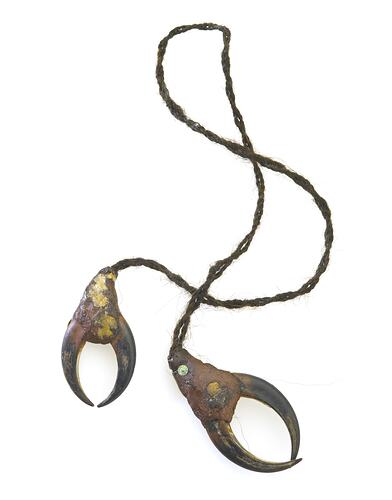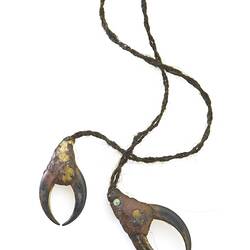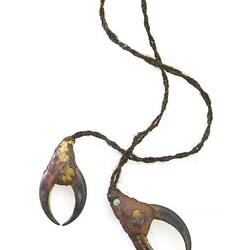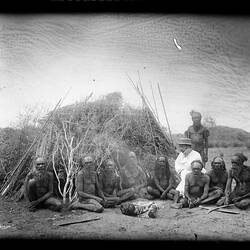Summary
The anthropologists Walter Baldwin Spencer (1860-1929) and Francis (Frank) Gillen (1855-1912) recorded a neck ornament precisely like this one as having been made by the Warumungu people near Tennant Creek. It has a pair of eaglehawk claws and the resin securing them to the string was probably made from spinifex or porcupine grass. They described this as 'somewhat unusual' in their book 'Northern Tribes of Central Australia' (1904) and noted that the string was tied so that the claws hung down the wearer's back. String made from human hair spun on a simple form of spindle was used by some central Australian Indigenous groups for a range of purposes, including ornaments like this one. Aboriginal people in central Australia produced a variety of body ornaments for both ceremonial and decorative purposes. Headbands, armlets, aprons, pubic tassels, pendants, neckbands and other adornments were made from a range of materials, and many have human hair string that was spun using a simple form of spindle. In some cases ornaments were 'sung' to give them certain magical powers and others were traded between neighbouring groups.
Physical Description
An ornament made of two strands of human hair string. The claws of an eagle hawk embedded in resin are attached to either end of the strings.
More Information
-
Object/Medium
Ornament, neck
-
Maker
-
Cultural Groups
-
Locality
Specific locality unrecorded, Desert North, Northern Territory, Australia
-
Date Produced
-
Date Collected
-
Object Measurements
430 mm (Length), 40 mm (Width), 10 mm (Height)
-
Keywords
-
Acquisition Information
Purchase from Francis J. Gillen, 30 May 1899
-
Collection Names
-
Type of item
-
Discipline
-
Category
-
Collecting Areas



